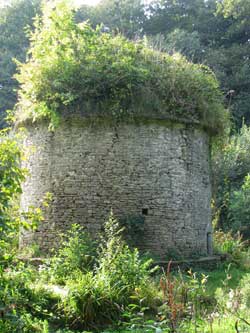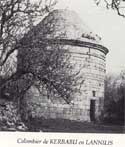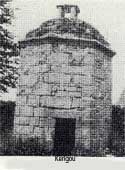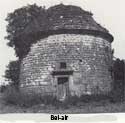
 |
| Dovecote of Trouzilit |
While several dovecotes are known to exist in the area to the north and west of Brest, the only one we had time to locate was the one near Treglonou. It is located in a small timbered valley, descending on a gentle slope from the mouth of the River Beniguet (River mouth Benoit). It must be of the 14th century, and with the exception of the door lintels, the base, and the nestboxes, the rest of the structure is made mostly out of smaller hard stones. As with many other dovecotes in Brittany, the base is made of rather substantial stones which are much larger and laid out in a larger diameter to provide a firm footing upon which the structure rests. The roof also provides a substantial overhang, protecting the walls from weather and the interior from climbing predators. The roof, sadly, is now overgrown with vegetation, as you can clearly see in the photograph. The door lintel is also sculpted of larger stone as well as the very unusual nestboxes. The dovecote's exterior diameter is roughly 22 feet, with the interior being 18 feet. The nestboxes start right at the line of the floor, and they are of the standard checkerboard pattern, with the nestholes increasing in size at the rear, and the slant inside alternating from left to right by row. They are arranged in 18 rows, divided into 3 sections by landing ledges. As noted above, the nestboxes are very unusual, being constructed of rather large stones. This increases the distance between the rows from what is normally found, and accounts for the significantly fewer nest holes, considering the size, of the dovecote, at just over 400, rather than the 600 one would expect.
The manor is about 1.2km southwest of Treglonou on the D28 from when you turn west in the center of town. The manor presently has a pony club, bar, tourist information center and lodging, so offers an ideal place to stay if you are in the area hunting for dovecotes. As you enter the manor drive, to the right behind a stone building is a map of the area that shows the path to the dovecote. It is private property and mainly used as a horse path, but pedestrians are permitted. No motorized vehicles. The folks at the manor were very helpful and directed us to the path. The path starts along a private road .4km from the manor towards Teglonou, and there is a small spot you can park a car there and another sign designating the path..
Other dovecotes in the area reported by Dr. Jean Auffret in Colombiers et Pigeonniers en Bretagne Profonde are noted below. We have provided small thumbnail images from the book to help you identify them. More detail on these dovecotes and larger images are in the book, which we highly recommend for any enthusiast. And of course, if you have any information on any of these or others you know of in the area that you would like to share, we would love to post it.
 |
Dovecote of Kerbabuen, LannilisThis lovely dovecote is made of large cut white stone and lies very close to the manor, and can be seen from the road.. It has 919 nestholes. The pedestal base for supporting the potence is equally robust and of well cut stone. The manor belonged to the Bellingant family during the 15th-18th centuries. Currently the Loiselets reside at the manor. |
 |
Dovecote of the manor of KerigouLuckily, while not much remains of Kerigou, the dovecote, as well as the vault, do. They lie in very close proximity to each other. Of the many dovecotes that can be found in Finistere, it is the only one constructed in the octagonal form. While octagonal outside, it is cylindrical inside, with a very tight internal diameter of only about 5 feet.. The access door is also characteristically tiny. The nestholes are laid out in 8 rows, and there are only 104 in total. It was the property of Monseigneur Jean-Gilles de Coetlosquet, born in 1700. The dovecote is located in a beautiful site, by the edge of sea, on bay of Carantec. |
 |
Dovecote of LestremeurThis dovecote is another rather unique specimen for Finistere. The tall column of the dovecote is incorporated into the manor. The German army used it as an observatory during WW II. Yves de Lesguen, husband of Marguerite Kerouartz, lived there in 1580. The manor has changed hands several times over the centuries and is currently in private ownership. It was not available for viewing even for Dr. Jean Auffret when he was compiling information for the book. However,.it can be seen from the road out to Treompan. Perhaps the current owners are less reclusive, and will share more information with us. |
 |
Dovecote of LanhallaThe dovecote of Lanhalla sits on a hilltop which dominates the coast of Lampaul-Plouarzel. It is undoubtedly the first dovecote in the area privileged with a sign for tourists directing one to its location. It dates from the 16th century. One of the owners, lord Tanguy de Lanhalla, appears to have resided there in 1503, and at that time was the most powerful lord of Plouarzel.. It is recorded that on February 16, 1684, the doves of the cote where used for a lavish marriage feast. The dovecote is comprised 630 nestholes. |
 |
Dovecote of Tremazan, Landunvez Tremazan is located at the end of the very beautiful part of the coast of the Legends, which begins with the Ildut river mouth. There is an old ruined castle on the site that was erected to counter the reccuring invasions of the English as well as the Normans. It is probably one of the oldest dovecotes in Brittany, and it must date from second half of the thirteenth century, probably built under Bernard of Chastel on his return from the eighth crusade, about 1270. |
 |
Dovecote of Bel-air in BrelesThis dovecote forms part of a unit comprising the manor house, built as a fortress, complete with with mighty watch towers. The manor defended the bottom of the Ildut river mouth against the incursions of the invaders. It can be seen by taking a casual and enjoyable stroll along the right bank of the river mouth. The dovecote is rather small, and of the usual type of the Finister dovecotes. The large stone that supported the potence is still present. Unfortunately, to avoid vandalism, the owner had to lock the door. |
DAY |
||||||||||||||||||
| 00 | 01 | 02 | 03 | 04 | 05 | 06 | 07 | 08 | 09 | 11 | 12 | 13 | 14 | 15 | 16 | 17 | 18 | |